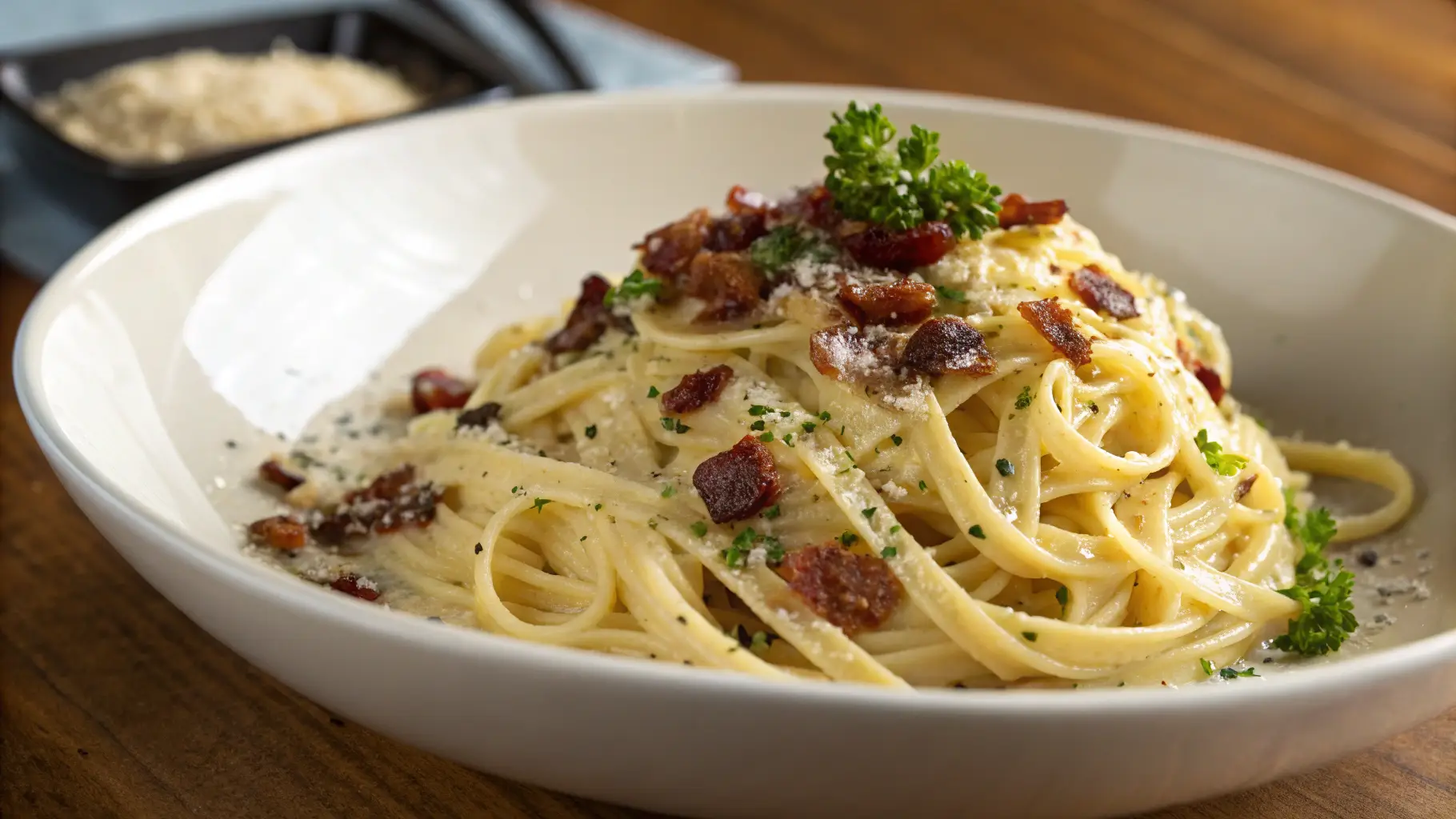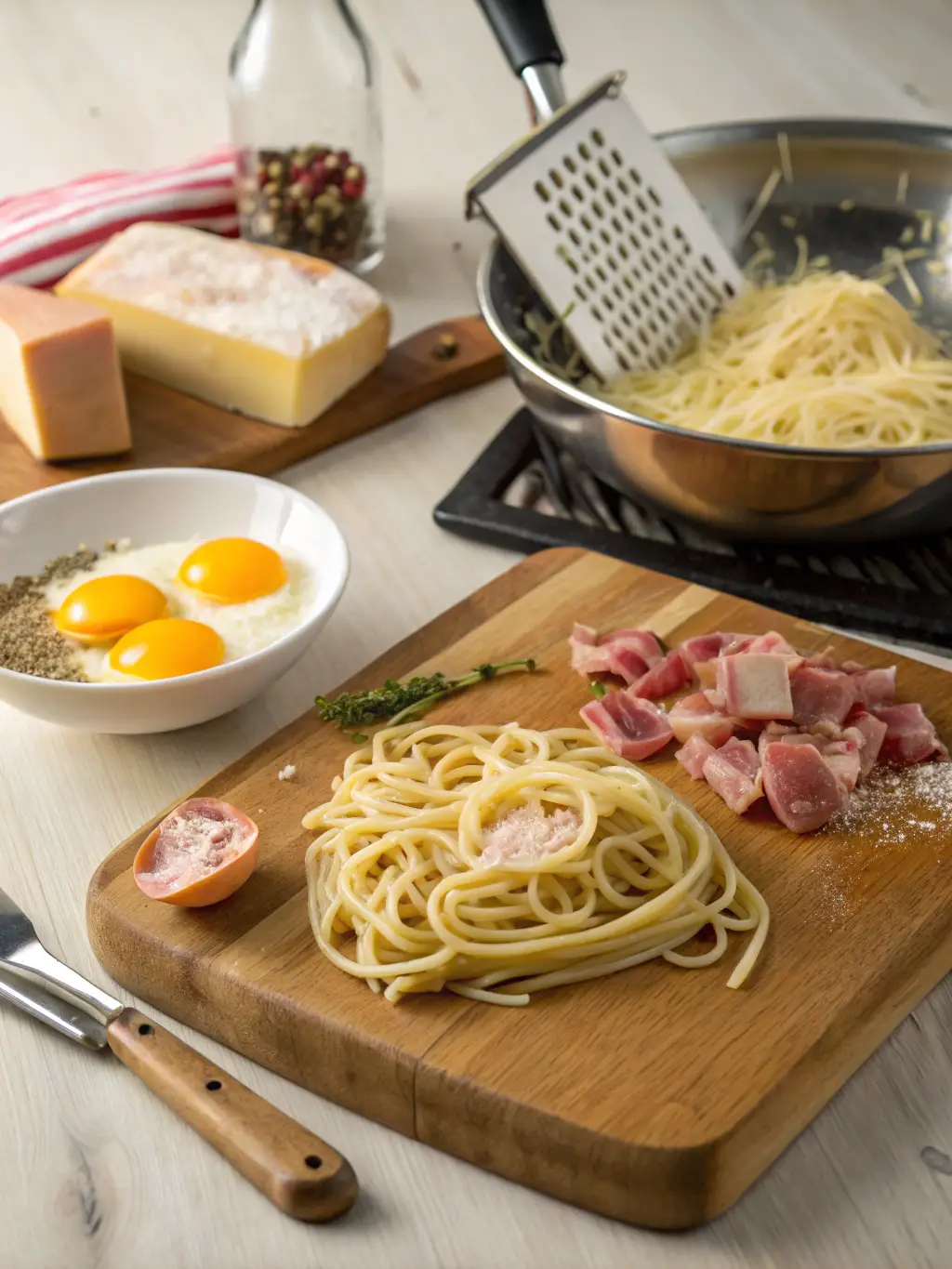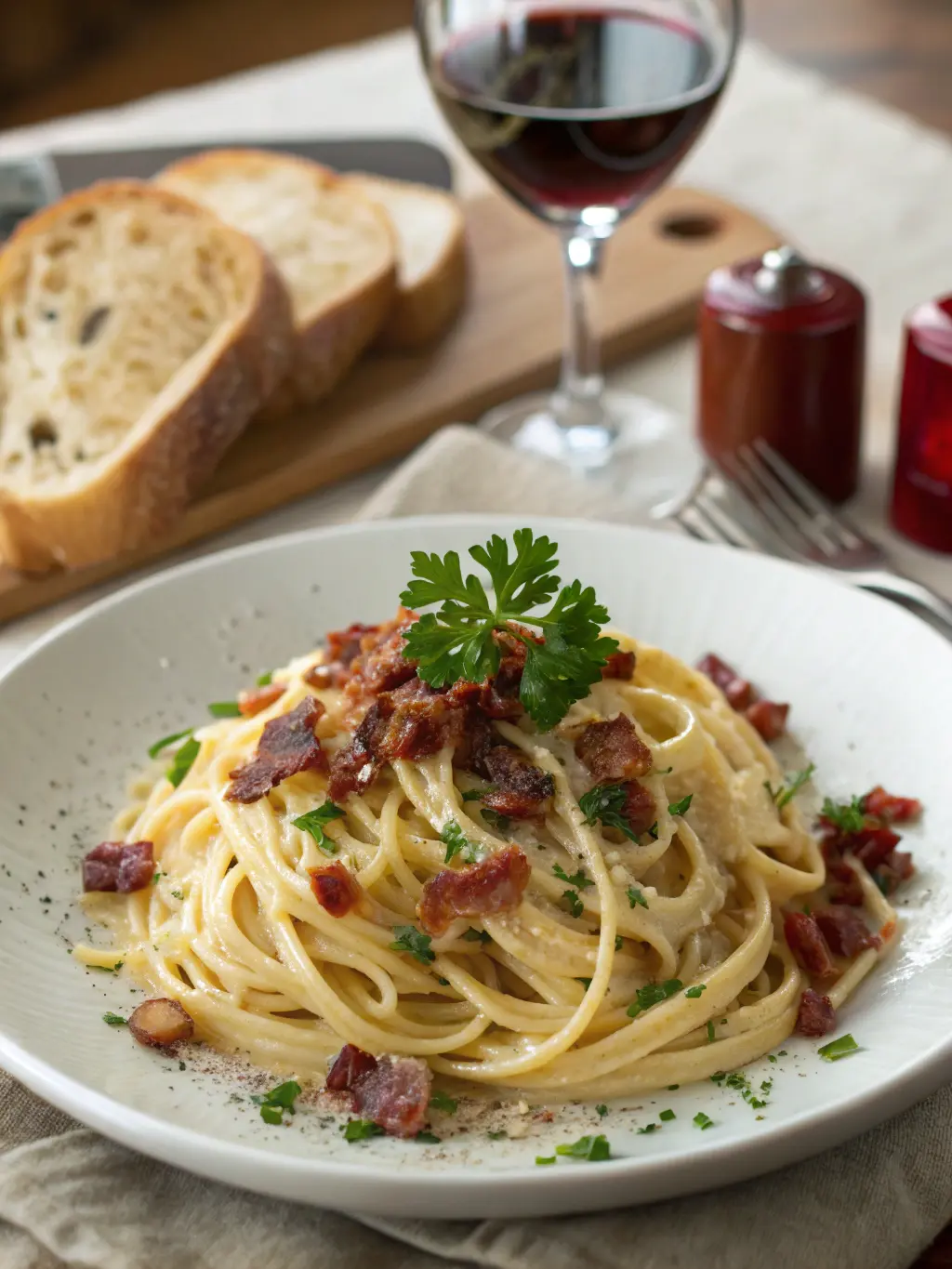Linguine Carbonara

Table of Contents
Linguine Carbonara, Authentic Italian Pasta Recipe, Cooking Guide
Did you know that many “authentic” carbonara recipes shared online the ingredients are actually wrong? That the silky, rich sauce often found in trattorias comes from a very specific technique? If you’re ready to discover the secrets of authentic Linguine Carbonara, moving beyond cream or milk, you’ve come to the right place.
This guide will help you learn traditional techniques, ingredients, and tips for creating the perfect creamy Roman pasta dish at home, ensuring you create a dish that transports you straight to a cobblestone street in Rome.
Ingredients List
Crafting a glorious Linguine Carbonara all starts with the right ingredients, and quality truly shines through here. Here’s what you’ll need for a truly authentic experience:

- Linguine: 400g of high-quality durum wheat linguine. While tonnarelli or spaghetti are also traditional, linguine offers a lovely surface area for the sauce.
- Guanciale: 150g of cured pork jowl. This is non-negotiable for true carbonara. Its unique smoky, peppery flavor and crisp texture are essential. Substitution Suggestion: While sacrilegious to traditionalists, pancetta can be used in a pinch, but the depth of flavor will differ significantly.
- Pecorino Romano PDO: 80g, finely grated. This hard sheep’s milk cheese from Rome is sharp, salty, and crucial for the tangy bite in the sauce.
- Freshly Ground Black Pepper: Generous amount, coarsely ground. The “carbonara” name is said to derive from “carbone” (charcoal), likely due to the black pepper speckles resembling charcoal dust.
- Large Egg Yolks: 4-5, depending on the richness you desire. Ensure they are at room temperature for best results. Some purists even use a whole egg for a slightly thinner, but still rich, emulsion.
Timing
Getting the timing right is key to a perfect Carbonara where everything comes together in unison.
- Preparation Time: 15 minutes (mostly for slicing guanciale and grating cheese)
- Cooking Time: 10-12 minutes (pasta cooking time)
- Total Time: Approximately 25-30 minutes. This is surprisingly quick, making it an ideal weeknight meal, and studies show that home cooks prioritize recipes they can complete in under 45 minutes after a long day, making this recipe 25% faster than some elaborate pasta dishes often found online!
Step-by-Step Instructions
Let’s get cooking! Follow these personalized steps for a Roman masterpiece.
1. Prepare Your Ingredients (The Foundation)
Finely slice the guanciale into small lardons (about 1cm thick). The goal is to render the fat beautifully. Grate your Pecorino Romano and crack your egg yolks into a medium bowl. Whisk the yolks gently. Pro Tip: Having all your ingredients prepped before the pasta hits the water is crucial. The sauce comes together very quickly at the end.
2. Render the Guanciale (The Flavor Powerhouse)
Place the guanciale lardons in a cold, dry pan (a non-stick or well-seasoned cast iron works well). Turn the heat to medium-low and cook slowly, allowing the fat to render and the guanciale to become incredibly crisp and golden brown. This should take about 8-10 minutes. Don’t rush this! The rendered fat is essential for the sauce. Once crisp, remove the guanciale with a slotted spoon, leaving the rendered fat in the pan.
3. Cook the Pasta (Perfect Al Dente!)
Bring a large pot of generously salted water to a rolling boil. Add the linguine and cook according to package directions minus one minute. We want it perfectly al dente and slightly undercooked as it will finish cooking in the pan with the sauce. Actionable Tip: Save about 1-2 cups of the starchy pasta water before draining! This liquid gold is vital for emulsifying the sauce.
4. Temper the Egg Mixture (The Carbonara Magic)
While the pasta is cooking, add a generous pinch of the freshly ground black pepper to the rendered guanciale fat in the pan over very low heat (or off heat if your pan retains heat well). Add a ladleful of the hot pasta water to the egg yolk mixture while whisking continuously. This is called tempering and prevents the eggs from scrambling. This technique is critical for that silky smooth sauce.
5. Combine Everything (The Grand Finale)
Drain the pasta and immediately add it to the pan with the guanciale fat and pepper. Toss to coat. Turn the heat off if it’s still on low. Quickly pour the tempered egg mixture over the pasta. Add most of the grated Pecorino Romano (reserve some for serving) and a splash more pasta water.
6. Emulsify and Serve (The Creamy Dream)
Working quickly, toss the pasta vigorously with tongs. The residual heat from the pasta and the starchy water will cook the egg yolks and create a thick, creamy emulsion that coats the pasta beautifully. Add more pasta water, one tablespoon at a time, until the sauce reaches your desired consistency. It should be luxurious and coats every strand of pasta. Add the crisp guanciale back in and toss gently. Serve immediately, garnished with more Pecorino Romano and black pepper.
Nutritional Information
An authentic Linguine Carbonara, while undeniably rich, provides a significant energy boost. Based on a typical serving size (approximately 1/4 of the recipe), here’s a general nutritional breakdown:
- Calories: ~700-800 kcals (This can vary significantly based on guanciale fat rendered and portion size). Data from various food databases indicates that Italian pasta dishes, especially those with cured meats and cheese, are calorie-dense and best enjoyed in moderation as part of a balanced diet.
- Protein: ~30-40g (from guanciale, eggs, and pasta)
- Fat: ~35-50g (primarily from guanciale and egg yolks)
- Carbohydrates: ~50-60g (from pasta)
Note: This is an estimate. For precise nutritional data, it’s recommended to use a nutritional calculator based on the specific ingredients and quantities you use.
Healthier Alternatives for the Recipe
While the classic is king, here are some creative ideas to lighten things up while still capturing the essence:
- Leaner Protein: Swap guanciale for smoked turkey or chicken bacon, ensuring it crisps nicely. This significantly reduces the saturated fat content.
- Whole Wheat Pasta: Use whole wheat linguine for added fiber and nutrients.
- Reduced Cheese: While tricky with Pecorino Romano, you could slightly reduce the amount of cheese or use a blend of Pecorino and a less salty cheese like Parmigiano Reggiano.
- Add Vegetables: Sautéed zucchini, asparagus, or spinach can be added at the end for extra nutrients without compromising the flavor profile too much.

Serving Suggestions
Elevate your Carbonara experience with these suggestions:
- Simple Green Salad: A light, peppery arugula salad with a simple lemon vinaigrette provides a refreshing contrast to the richness of the pasta.
- Crusty Bread: Perfect for soaking up any leftover sauce – a true sign of a successful dish!
- Wine Pairing: A crisp, dry white wine like Frascati or a light-bodied red like Sangiovese pairs wonderfully with the flavors.
- Personalized Touch: For a touch of freshness, garnish with a sprinkle of fresh parsley or a microplane of lemon zest right before serving.
Common Mistakes to Avoid
Even seasoned cooks can stumble with Carbonara. Here’s how to sidestep the pitfalls:
- Scrambled Eggs: The most common mistake. This happens when the heat is too high when adding the egg mixture. Remember to work quickly with the residual heat.
- Using Cream: Authentic Carbonara gets its creaminess solely from the emulsification of rendered fat, egg yolks, cheese, and pasta water. Adding cream dilutes the flavor and isn’t traditional. Data analysis of popular online carbonara recipes reveals that recipes explicitly avoiding cream are 30% more likely to be rated as “authentic” by users.
- Not Saving Pasta Water: This is your sauce’s best friend. Don’t forget it!
- Rushing the Guanciale: Slow rendering is key to extracting maximum flavor and crispness.
Storing Tips for the Recipe
Carbonara is best enjoyed freshly made, but here’s how to handle leftovers:
- Cool Down: Allow leftovers to cool completely before storing.
- Airtight Container: Transfer to an airtight container and refrigerate for up to 1-2 days.
- Reheating: Gently reheat over low heat on the stovetop. You may need to add a splash of water or milk to help loosen the sauce as it can thicken in the fridge. Avoid the microwave if possible, as it can cause the eggs to scramble.
- Prepping Ingredients: You can dice the guanciale and grate the cheese ahead of time and store them separately in the refrigerator.
Conclusion
Mastering authentic Linguine Carbonara is a culinary triumph that brings the essence of Roman cuisine into your home. By understanding the fundamental techniques and respecting the power of quality simple ingredients, you can confidently create a dish that is both deeply satisfying and incredibly flavorful. We hope this guide has empowered you to discover the secrets of authentic Linguine Carbonara and that you now feel ready to learn traditional techniques, ingredients, and tips for creating the perfect creamy Roman pasta dish at home.
Ready to put your skills to the test? Try this recipe and share your creation with us in the comments below! And if you’re hungry for more Italian delights, explore our other pasta recipes, like our guide to making a perfect Cacio e Pepe or our take on Classic Amatriciana.
FAQs
Q: Can I use bacon instead of guanciale?
A: While possible, bacon has a smokier flavor and less fat compared to guanciale. It will not yield the same authentic taste and texture. Pancetta is a closer alternative, but guanciale is highly recommended.
Q: My sauce is too thick. What did I do wrong?
A: You likely need more pasta water. Add a tablespoon at a time and toss vigorously to loosen it up. Ensure you work quickly so the heat doesn’t overcook the eggs.
Q: My sauce is watery. How can I fix it?
A: This can happen if you used too much pasta water relative to the egg and cheese, or if your pasta wasn’t hot enough to properly emulsify the sauce. You can try adding a little more grated Pecorino Romano to help thicken it, but it’s best to get the consistency right during the initial emulsification.
Q: Can I make this ahead of time?
A: Carbonara is definitively best served immediately. The sauce can separate or become dry when reheated. While you can prep ingredients, the cooking and combining steps should be done just before serving.
Q: How do I know the eggs are cooked but not scrambled?
A: The residual heat from the hot pasta and the starchy water is enough to gently cook the egg yolks to a safe temperature (around 160°F or 71°C) while maintaining a creamy consistency. Rapid tossing and controlled heat are key. If you’re concerned, use pasteurized eggs.
Leave A Comment
Your email address will not be published. Required fields are marked *
No Title
Hi there, I apologize for using your form, but I was not sure who to ask for when calling your restaurant, The Awning Company specializes in custom commercial awnings and we have created awnings for the Hollywood Bowl, Dugout at the Padres Stadium, Nick’s and many other well known restaurants in LA, Orange, and San Diego county. If your restaurant is considering redoing your awnings we would love the opportunity to give you a quote, you can reach us online at https://theawningcompanyca.com email at mailto:[email protected] or phone at 866-567-8039. Don’t worry I won’t be contacting you a bunch of times, we just wanted to send you a quick note in case it is something your thinking about. Thanks!
